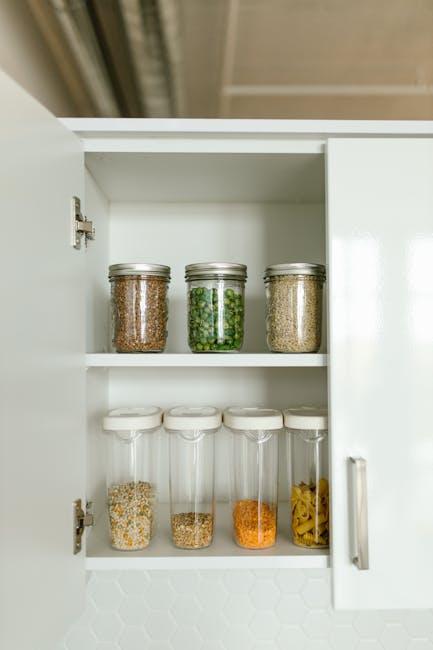Step into any kitchen, and the fridge often tells a story-not just of the meals planned or leftovers waiting for a second act, but of the chaos hiding behind the closed door. Organizing a refrigerator can feel like an endless puzzle, with condiments toppled and vegetables lost in the depths. Yet, a well-arranged fridge is more than just a tidy shelf; it’s a gateway to fresher ingredients, less waste, and a smoother cooking experience. In this article, we explore fridge organization hacks that actually work-simple, practical strategies designed to transform your chilly storage space into an efficient, inviting hub that makes everyday life just a little bit easier.
Smart Storage Zones for Maximum Freshness

Creating designated zones within your fridge tailored to specific types of food can dramatically extend their shelf life. Fruits, vegetables, dairy, and meats each have unique temperature and humidity requirements. By using adjustable bins or smart organizers, you can control these environments effectively. For instance, keeping fruits in low-humidity drawers helps prevent mold growth, while high-humidity zones preserve leafy greens by maintaining crispness.
Consider setting up a smart zone matrix for effortless freshness management. Organize your fridge with these guided compartments:
- Herbs & leafy greens: Moist, enclosed section to keep them vibrant
- Cheese & dairy: Cooler, stable temperature shelf away from door fluctuations
- Raw meats: Lowest shelves to avoid cross-contamination and maintain the coldest setting
- Fruits: Medium humidity drawer to extend juiciness
| Food Type | Best Storage Zone | Ideal Condition |
|---|---|---|
| Berries | Upper Shelf | Low humidity, consistent temp |
| Leafy Greens | Lower Drawer | High humidity, cool |
| Raw Chicken | Bottom Shelf | Coldest temp, separate |
| Cheddar Cheese | Mid Shelf | Stable temp, wrapped |
Clear Containers and Labels for Easy Access

Transform your fridge into a visually appealing and efficient storage haven by swapping out mismatched containers for clear, uniform ones. These transparent vessels let you quickly spot what’s inside without rummaging through, saving valuable time and reducing food waste. Pairing this with airtight seals keeps ingredients fresh longer, maintaining the quality of your groceries. The clarity not only streamlines access but also creates a cohesive look, turning your fridge into a tidy, magazine-worthy space.
To maximize this setup, label each container with contents and expiration dates using waterproof markers or chic chalkboard stickers. Here’s a quick guide to easy labeling:
- Use color coding: Assign colors for categories like dairy, veggies, or leftovers.
- Date every batch: Keep track of freshness effortlessly.
- Be specific: Write exact names instead of vague terms.
| Container Type | Best For | Label Tip |
|---|---|---|
| Stackable Square | Leftovers & prepped meals | Use date + main ingredient |
| Small Round Jars | Herbs & spices | Color code by herb type |
| Large Rectangular | Fruits & veggies | Write veggie name & purchase date |
Temperature Tips to Keep Food Longer

Keeping your fridge at the right temperature is the secret weapon to extending the life of your perishables. Ideally, your refrigerator should be set between 34°F and 38°F (1°C to 3°C). This range is cool enough to slow bacterial growth without freezing your fresh produce. Meanwhile, the freezer should stay at a steady 0°F (-18°C) to preserve your frozen goods without compromising texture or flavor. Investing in a reliable fridge thermometer can help you avoid temperature fluctuations that might spoil your food prematurely.
Organize your fridge with temperature zones in mind to maximize freshness:
- Top shelves: perfect for ready-to-eat items and leftovers.
- Middle shelves: great for dairy and eggs where the temperature is most consistent.
- Bottom shelves: ideal for raw meat and fish, as this area is coldest and prevents cross-contamination.
- Crisper drawers: adjust humidity settings-high for leafy greens, low for fruits-to maintain crispness.
| Food Type | Ideal Fridge Zone | Optimal Temperature |
|---|---|---|
| Leafy Greens | Crisper drawer (High Humidity) | 34°F – 38°F |
| Dairy | Middle Shelves | 36°F – 38°F |
| Meat & Fish | Bottom Shelf | 34°F – 36°F |
| Fruits | Crisper drawer (Low Humidity) | 36°F – 38°F |
Regular Maintenance Rituals to Prevent Clutter

Establishing a weekly routine can transform your fridge from a chaos zone into a streamlined haven. Dedicate just 10 minutes to sweep through all shelves, swiftly discarding anything past its prime or no longer edible. Rotate older items front and center to encourage timely usage, reducing waste. This habit keeps your refrigerator fresh and prevents the gradual buildup of forgotten containers and mysterious leftovers.
Consider creating a simple checklist for your fridge’s weekly upkeep, like the one below, to keep clutter at bay effortlessly:
| Task | Time to Complete | Frequency |
|---|---|---|
| Check expiration dates | 3 minutes | Weekly |
| Wipe down shelves | 4 minutes | Weekly |
| Organize condiments & sauces | 3 minutes | Weekly |
- Tip: Use clear bins to group similar items-it makes quick visual scans easy and prevents duplicate purchases.
- Tip: Keep a small notepad or digital note nearby to jot down items you’re running low on as you tidy.
Wrapping Up
In the end, a well-organized fridge isn’t just about neatness-it’s a daily invitation to healthier choices, less waste, and a little peace of mind. With these fridge organization hacks that actually work, you’re not just tidying up a space; you’re streamlining your routine and giving your food the care it deserves. So open that door with confidence, knowing everything has its place and every snack awaits with ease. Here’s to a cooler, smarter, and more appetizing kitchen experience-one perfectly arranged shelf at a time.














